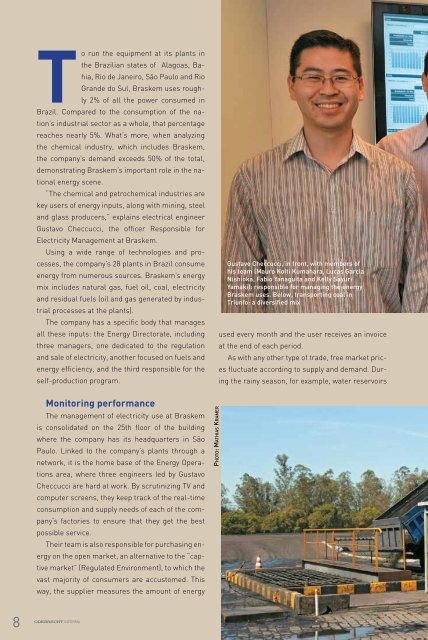ENERGY - Odebrecht Informa
ENERGY - Odebrecht Informa
ENERGY - Odebrecht Informa
Create successful ePaper yourself
Turn your PDF publications into a flip-book with our unique Google optimized e-Paper software.
To run the equipment at its plants in<br />
the Brazilian states of Alagoas, Bahia,<br />
Rio de Janeiro, São Paulo and Rio<br />
Grande do Sul, Braskem uses roughly<br />
2% of all the power consumed in<br />
Brazil. Compared to the consumption of the nation’s<br />
industrial sector as a whole, that percentage<br />
reaches nearly 5%. What’s more, when analyzing<br />
the chemical industry, which includes Braskem,<br />
the company’s demand exceeds 50% of the total,<br />
demonstrating Braskem’s important role in the national<br />
energy scene.<br />
“The chemical and petrochemical industries are<br />
key users of energy inputs, along with mining, steel<br />
and glass producers,” explains electrical engineer<br />
Gustavo Checcucci, the officer Responsible for<br />
Electricity Management at Braskem.<br />
Using a wide range of technologies and processes,<br />
the company’s 28 plants in Brazil consume<br />
energy from numerous sources. Braskem’s energy<br />
mix includes natural gas, fuel oil, coal, electricity<br />
and residual fuels (oil and gas generated by industrial<br />
processes at the plants).<br />
The company has a specific body that manages<br />
all these inputs: the Energy Directorate, including<br />
three managers, one dedicated to the regulation<br />
and sale of electricity, another focused on fuels and<br />
energy efficiency, and the third responsible for the<br />
self-production program.<br />
Gustavo Checcucci, in front, with members of<br />
his team (Mauro Koiti Kumahara, Lucas Garcia<br />
Nishioka, Fabio Yanaguita and Kelly Sayuri<br />
Yamaki): responsible for managing the energy<br />
Braskem uses. Below, transporting coal in<br />
Triunfo: a diversified mix<br />
used every month and the user receives an invoice<br />
at the end of each period.<br />
As with any other type of trade, free market prices<br />
fluctuate according to supply and demand. During<br />
the rainy season, for example, water reservoirs<br />
Monitoring performance<br />
The management of electricity use at Braskem<br />
is consolidated on the 25th floor of the building<br />
where the company has its headquarters in São<br />
Paulo. Linked to the company’s plants through a<br />
network, it is the home base of the Energy Operations<br />
area, where three engineers led by Gustavo<br />
Checcucci are hard at work. By scrutinizing TV and<br />
computer screens, they keep track of the real-time<br />
consumption and supply needs of each of the company’s<br />
factories to ensure that they get the best<br />
possible service.<br />
Their team is also responsible for purchasing energy<br />
on the open market, an alternative to the “captive<br />
market” (Regulated Environment), to which the<br />
vast majority of consumers are accustomed. This<br />
way, the supplier measures the amount of energy<br />
Photo: Mathias Kramer<br />
8<br />
informa
















